
The United States Capitol, often called the Capitol or the Capitol Building, is the seat of the United States Congress, the legislative branch of the federal government. It is located on Capitol Hill at the eastern end of the National Mall in Washington, D.C. Although no longer at the geographic center of the city of Washington, the Capitol forms the origin point for the street-numbering system of the district as well as its four quadrants.

A portrait is a painting, photograph, sculpture, or other artistic representation of a person, in which the face and its expressions are predominant. The intent is to display the likeness, personality, and even the mood of the person. For this reason, in photography a portrait is generally not a snapshot, but a composed image of a person in a still position. A portrait often shows a person looking directly at the painter or photographer, to most successfully engage the subject with the viewer.
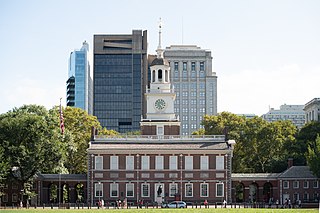
Independence Hall is a historic civic building in Philadelphia, where both the United States Declaration of Independence and the United States Constitution were debated and adopted by America's Founding Fathers. The structure forms the centerpiece of the Independence National Historical Park. Independence Hall was named to the National Register of Historic Places in 1966 and as a World Heritage Site in 1979.
Southern Democrats are members of the U.S. Democratic Party who reside in the Southern United States.

Lynn Morley Martin is an American businesswoman and former politician who served as the 21st United States secretary of labor from 1991 to 1993, under President George H. W. Bush. A member of the Republican Party, she previously represented Illinois's 16th congressional district in the United States House of Representatives from 1981 to 1991. Before her election to Congress, Martin served in both chambers of Illinois General Assembly; in the State House of Representatives from 1977 to 1979, as well as the State Senate from 1979 to 1980.
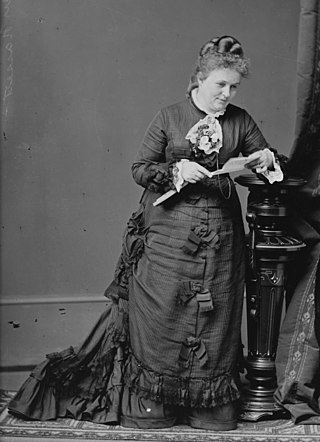
Cornelia Adele Strong Fassett was an American painter. She painted portraits of politicians. Her most famous work is her painting of the Electoral Commission of 1877.
Censure is a formal, public, group condemnation of an individual, often a group member, whose actions run counter to the group's acceptable standards for individual behavior. In the United States, governmental censure is done when a body's members wish to publicly reprimand the president of the United States, a member of Congress, a judge or a cabinet member. It is a formal statement of disapproval. It relies on the target's sense of shame or their constituents' subsequent disapproval, without which it has little practical effect when done on members of Congress and no practical effect when done on the president.

The United States Capitol building features a central rotunda below the Capitol dome. Built between 1818 and 1824, the rotunda has been described as the Capitol's "symbolic and physical heart".

Francis Bicknell Carpenter was an American painter born in Homer, New York. Carpenter is best known for his painting First Reading of the Emancipation Proclamation of President Lincoln, which is hanging in the United States Capitol. Carpenter resided with President Lincoln at the White House and in 1866 published his one-volume memoir Six Months at the White House with Abraham Lincoln. Carpenter was a descendant of the New England Rehoboth Carpenter family.

Frederick Delbert Schwengel was a Republican U.S. Representative from southeastern Iowa.
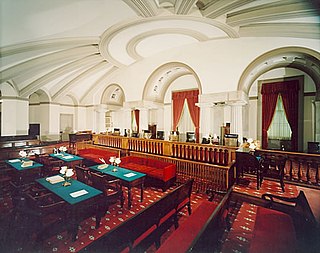
The Old Supreme Court Chamber is the room on the ground floor of the North Wing of the United States Capitol. From 1800 to 1806, the room was the lower half of the first United States Senate chamber, and from 1810 to 1860, the courtroom for the Supreme Court of the United States.
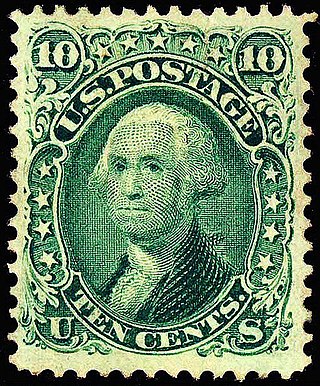
Presidents of the United States have frequently appeared on U.S. postage stamps since the mid-19th century. The United States Post Office Department released its first two postage stamps in 1847, featuring George Washington on one, and Benjamin Franklin on the other. The advent of presidents on postage stamps has been definitive to U.S. postage stamp design since the first issues were released and set the precedent that U.S. stamp designs would follow for many generations.
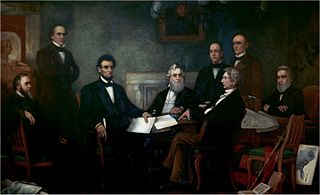
First Reading of the Emancipation Proclamation of President Lincoln is an 1864 oil-on-canvas painting by Francis Bicknell Carpenter. In the painting, Carpenter depicts Abraham Lincoln, the 16th president of the United States, and his Cabinet members reading over the Emancipation Proclamation, which proclaimed the freedom of slaves in the ten states in rebellion against the Union in the American Civil War on January 1, 1863. Lincoln presented the preliminary Emancipation Proclamation to his Cabinet on July 22, 1862 and issued it on September 22, 1862. The final Emancipation Proclamation took effect on January 1, 1863.

Abraham Lincoln is an 1869 oil-on-canvas painting by George Peter Alexander Healy of Abraham Lincoln, the 16th president of the United States.
The following outline is provided as an overview of and topical guide to Abraham Lincoln:

There are several works of art in the United States Capitol honoring former leaders of the Confederate States of America and generals in the Confederate States Army, including seven statues in the National Statuary Hall Collection, busts and portraits.

During his presidency, Andrew Johnson, the 17th president of the United States, saw multiple efforts during his presidency to impeach him, culminating in his formal impeachment on February 24, 1868, which was followed by a Senate impeachment trial in which he was acquitted.

Edmund Stuart Bittinger, better known by Ned Bittinger, is an American portrait painter and illustrator who is known for his paintings of prominent American figures. His notable works include the congressional portraits of Abraham Lincoln and Lindy Boggs for the United States Capitol, as well as Secretaries of State James Baker and Lawrence Eagleburger's official State Department portraits. He has also painted official portraits of Henry Kissinger, John Mica, and Jon Corzine, among others.

Corinne Claiborne (Lindy) Boggs is a 2004 oil-on-canvas portrait painting by Ned Bittinger of Congresswoman Lindy Boggs. The portrait hangs in the United States Capitol and is a part of the United States House of Representatives collection.

















